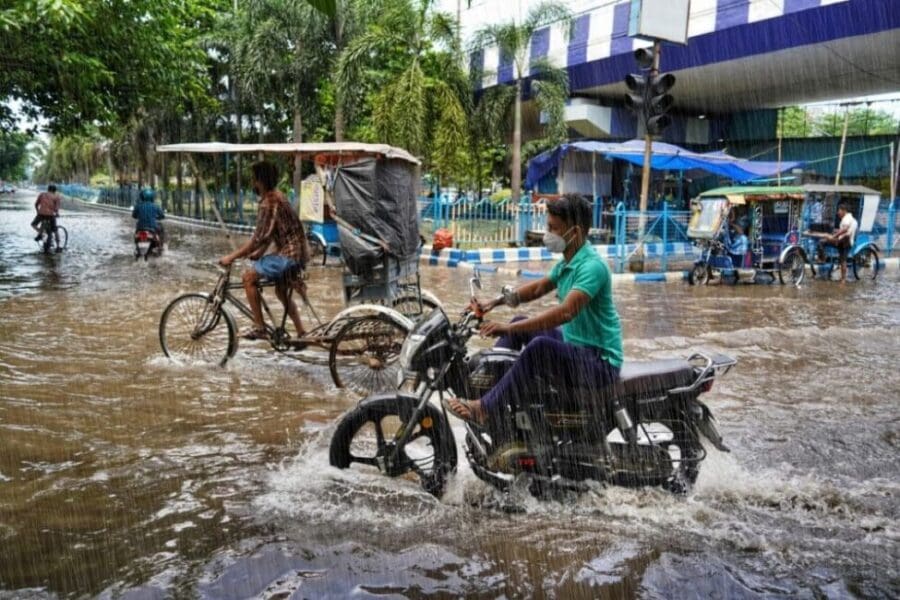By Amita Bhide, Tata Institute of Social Sciences, Mumbai | 360info
To avoid floods, Indian cities need to engage in nuanced, localised and comprehensive planning and development decisions.
Mumbai is unique among coastal cities.It’s not only surrounded by the Arabian Sea it also has four rivers — Mithi, Dahisar, Oshiwara and Poisar — passing through it. There are also four creeks — Malad, Mahim, Mahul and Thane.
All these waterways make the city of 21 million especially prone to floods during monsoon season.
The tidal effects of the rivers and creeks have a direct impact on the city’s drainage system, particularly when high tides coincide with heavy rainfall.
Take the Mithi River. It has been a crucial drainage channel and land reclamation around its flood plains was an important strategy in the development of the city’s suburbs. The original reclamation plans ncluded expansion of the water channels, providing holding ponds and drainage systems that have since become pointless.
The present development is such that the average width of the river is only 10 metres at most places along its length. There are no holding ponds while the land reclamation has gone ahead with added intensity due to pressure of commercial development in areas like the Bandra Kurla Complex. Consequently, when the monsoon rains come, Mithi’s floodplains are inundated especially when heavy rains and high tide coincide.
Mumbai is not unique in transforming its landscape into a densely built up one. Many cities tend to expand, changing their original land and waterscapes so they become prone to flooding. Just look at the destruction of the traditional ‘eris’ or traditional tank system for water storage, in Chennai , the lakes in Bengaluru and the rock- lake formations in Hyderabad.
More recent developments also have a tendency to identify the poor and their settlements along water/rivers/drains as the cause for the floods and hence relocate them to enable the development of commercial infrastructure.
The construction of the Akshardham Temple complex and the Commonwealth Games village in the Yamuna River floodplains in Delhi after the eviction of several settlements is one such example. Such developments point to the piecemeal nature of adaptive efforts that make the poor more vulnerable.
Once again, India is witnessing the arrival of the southwest monsoon, filling cities with an anticipation and anxiety about adequate rainfall on the one hand and the prospects of flooding, on the other.
This has been the case with cities across India’s various climatic zones.
Monsoon floods are accompanied by immense miseries, the activation of disaster management services and deployment of the security forces to manage casualties and damage.
Whenever there is monsoon flooding of cities, the narrative centres around the opposition accusing the party in power in the city and the state government of incompetence while the latter defends itself citing excessive, unnatural rainfall or climate change.
There is both a generalised and highly localised analysis of the causes – unplanned developmentn and incompleteness of annual desilting or drain-cleaning works.
This is followed by the announcement of grand mitigation projects in flood prone cities such as the construction of large underground tanks at various flooding hotspots (in Mumbai), integrated flood management project (in Chennai), a strategic drainage development programme (in Hyderabad) and a celebration of the resilience of the city and its citizens.
Such discourse tends to deviate from a real analysis of the relationship between the city’s eco-environment and urban development plans. It identifies solutions that are far too compartmentalised and often do not address the city’s vulnerabilities.
Floods can be predicted. The claim they occur due to exceptionally high rainfall, climate change and factors beyond human control is to underplay the responsibility of the state.
The veracity of the claim becomes questionable when seen along with statistics that in most cases show a pattern of gradual rather than sudden change in rainfall. Hence, the possibility of prediction, preparation and strategic preventive decisions.
Linked to this is the assertion that no disaster is a natural one. Hydraulic environments are actively and historically produced. Floods and their occurrence, the geographies that are flooded, the unevenness of their intensity across localities are all aspects linked to how the city’s moisture and water systems are planned, engineered and re-designed at different points in time.
In several Indian cities, land reclamation, filling in of wetlands, encroachment over lakes and ponds and the building up of river channels are enabled by city planning and, in the Indian context, by unauthorised developments.
The cumulative impact of such developments over the years is that while the built-up areas in cities are rising considerably, natural areas are decreasing significantly. This adds considerable pressure to already burdened and incomplete drainage systems.
The urban planning maps of cities are systematically manipulated to record rivers as “nalas” (natural drains) to deny the existence of pre-existing ponds or lakes and show them as land.
The incorporation of citizen knowledge and practices has added to the number of flooding hotspots in Mumbai from 68 in 2021 to more than 120 in 2022. Such knowledge can also add to the understanding of historical land and waterscapes of local eco-histories, leading to better solutions.
Unless Indian city governments learn to engage in more nuanced, localised, comprehensively informed planning and development decisions, cities will continue to experience floods on a recurring basis.
Amita Bhide is Professor, Centre for Urban Policy and Governance in the School of Habitat Studies, Tata Institute of Social Sciences, Mumbai, India.
Originally published under Creative Commons by 360info™.
Featured image credit: Dibakar Roy | Unsplash




